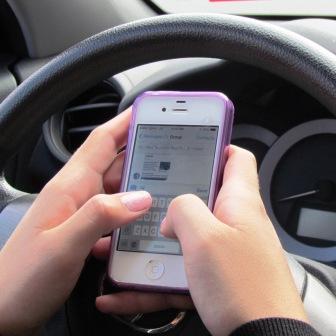
Like never before people communicate by text. Widespread wireless service expansion and increasingly affordable smart phones bring texting into the hands of nearly everyone. But when texting moves into the driver’s seat of a motor vehicle the distraction is disastrous.
Pedestrians face their own dangers. The U.S Consumer Product Safety Commission reports 1,152 pedestrians required emergency room treatment in hospitals for injuries suffered while walking and using a cell phone or other electronic device in the year 2011 alone.
Texting and Driving Statistics
Texting while driving makes an accident 23 times more likely according to National Highway Traffic Safety Administration (NHTSA) statistics. Sending or receiving a text takes a driver’s eyes off the road an average of 4.6 seconds. At 55 miles an hour that driver hurdles down the road blind the length of a football field. That’s also according to the NHTSA.
Texting and Driving Laws
At the time of this blog post 41 states and the District of Columbia ban text messaging for all drivers. Massachusetts and New Hampshire ban such conduct. The Governors Highway Safety Association, a national group, also reports that all but 4 of those states allow primary enforcement. Primary enforcement authorizes police to pull drivers over for texting without any other violation.
Texting and Driving: Criminal Penalties
Texting and driving carries penalties including jail and lengthy driver’s license suspensions. An 18-year-old Massachusetts driver learned the hard way after causing a fatal accident on February 20, 2011. Aaron Deveau sent and received 193 texts that day including several messages just moments before his vehicle swerved across the center line of a Haverhill, MA street, crashing head on into the vehicle of a 55-year-old father of three, killing the driver. The texter was sentenced to 2 ½ years behind bars, he’ll serve 1, and a 15 year loss of his driver’s license.
Texting and Driving: Civil Penalties
In addition to criminal penalties, texting drivers who cause harm face civil law suits and judgments. Violation of anti-texting laws provides evidence of negligence in many states and can lead to heavy civil judgments against the distracted driver.
A Carnegie Mellon University study using brain imaging documented that even just listening on a cell phone reduces by 37 percent the amount of brain activity available for driving. This caused study subjects in driving simulators to weave out of their lane. Out on the road in real life, such driver inattention often causes catastrophic results in a moment, with no time to react.
[Research assistance and co authorship by Courtney Babel.]
Views: 5





This is very important for people to realize. That if you do not pay attention constantly while driving a car, bad things can happen very fast and it is not worth killing people to just have crazy conversations going back and forth.